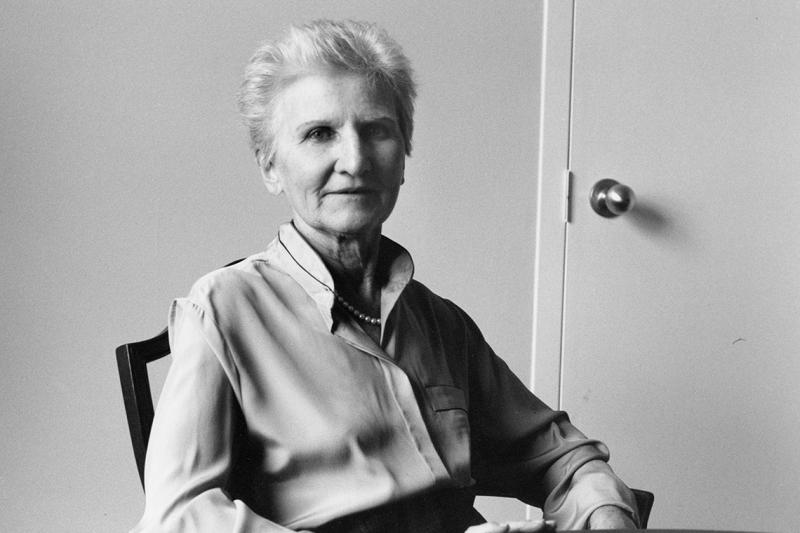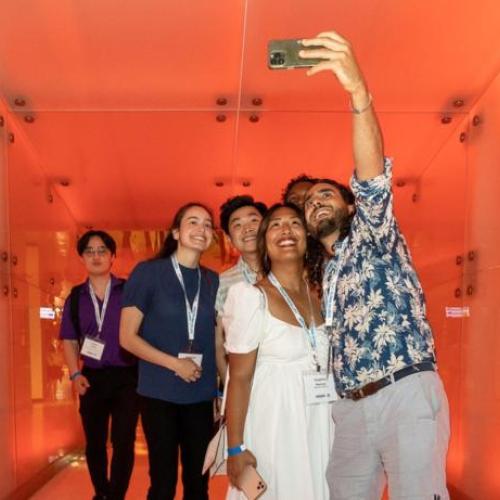March 7, 2018 | Alumni
"Absolutely fearless" alumna Dr. Lillian Lome travelled the world on medical missions
By Mary Gooderham

Dr. Lillian Lome (photo by Joni MacLaurin)
To her friends and family, Dr. Lillian Lome (BA 1938 St. MIKE'S, MD 1941) was fearless, a woman who didn't let anything get in her way.
She worked hard to get into medical school at University of Toronto, graduating in 1941, one of a few women in her class at the time. She raised a family and became a well-known family doctor in the city, but later in life pursued her dream to go on medical missions to the Caribbean and Africa. She continued to practise as a doctor well into her 80s.
"She loved a challenge and she was fearless, absolutely fearless,” says Sheila Craig Waengler, a friend of the Lome family. "She was a pioneer."
Lome, who died in November at the age of 101, was born Lillian Teresa Karmalska in Toronto on Feb. 21, 1916, to parents who were immigrants from Poland – her mother was a seamstress and her father, a tailor. She attended high school at St. Joseph’s Convent and got a General Proficiency Scholarship to attend medical school at U of T. There, she won the Dr. Ellen Mickle Fellowship, which was given for the highest standing in third year and academic excellence in fourth year.
“She had to work hard to get those scholarships to put herself through school,” says her daughter Carol Lome, noting her mother attended U of T with Dr. Ricky Schachter, who was also the daughter of immigrants and would go on to become a renowned dermatologist.
Carol Lome says her mother and Schachter would talk about the reluctance at the time to allow women to become doctors, “especially if they had foreign-sounding names.” Lome and Schachter also were told they had to pass a swimming test as part of their qualifications, “but they couldn’t swim, so they had someone at the Y teach them.”
Edward Shorter, a social historian who is the Hannah Chair in the History of Medicine at the Faculty of Medicine, says that during the Second World War, “the demand for physicians was going through the ceiling. The country was desperate for all the medical graduates they could get.”
Shorter, author of Partnership for Excellence: Medicine at the University of Toronto and Academic Hospitals, says the U of T medical school, which had merged with the Women’s Medical College in the decade before the First World War, had a quota system where one-fifth of students could be women. “They didn’t want a lot of female physicians, but they wanted some,” he says.

In the student yearbook, Lome is pictured on a page (above) with all men in the medical program. Her entry notes that she was on the executive of the Medical Women’s Athletic Club and the U of T Medical Journal, as well as president of the campus Polish club.
After graduation, with the war raging, Lome first worked as a staff physician at John Inglis and Company, a Toronto company that made weapons for the United Kingdom and British Commonwealth military forces. She cared for metalworkers making machine guns and pistols at the company, which would later become major appliance manufacturer Whirlpool Canada.
She soon moved to an internship at St. Michael’s Hospital, where she met her husband John Boye Lome, a pilot in the Norwegian Air Force whom she treated after his plane made a forced landing in Hamilton. They married on New Year’s Eve in 1943, and had five children.
Lome gave up her medical practice for 15 years until her youngest child, Carol, started school. She re-interned and started a practice at Women’s College Hospital, focusing on obstetrics. Despite her busy schedule, she remained devoted to her family, taking Carol along in the car, armed with a pile of library books, when she made her many house calls.
“She was one of the old breed: If you couldn’t get to her, she would come to you,” says her son Doug Lome.
He says his mother sympathized deeply for her patients and didn’t charge families who could not afford to pay. She was always open to learning, even studying acupuncture for 10 months in China. “When she got back, I was her guinea pig. I had bad sinuses and she put me on the examining table with all the needles sticking out of me. I’m not sure that it did much for my sinuses, but it was very relaxing,” he says.
Lome’s husband died in 1965. She worked at Women’s College until 1981, and after retiring moved her medical practice to the basement of her home. Toward the end of her career, she moved on to psychotherapy and worked for an insurance company doing medical examinations.
She remained on the courtesy staff at Women’s College and took up medical work in more remote locations, from a regular stint at a First Nations reserve in Northern Ontario to missions in communities in Ethiopia, Tanzania and Haiti.
In 1985, she was profiled in an article in the Toronto Sun titled “Grandma doc off to Ethiopia,” in which she talked about how she was disillusioned with the instant results that her North Toronto patients expected from medicine.
“Call it a second chance,” she told the newspaper. “I’m 69 and in excellent health and really have wanted to (work in) a Third World country for a number of years.”
In an item in a Women’s College staff newsletter after returning from Haiti in 1986, Lome wrote: “Even now I have to stop to remind myself of the countless blessings we in a modern hospital located in a city like Toronto take for granted, blessings which are the envy of two-thirds of the globe.”
These were places with little electricity and few medical supplies, but Lome was up to the challenge. Soon after arriving in Tanzania, she developed shingles on her back, which she treated herself with bandages doused in the Johnny Walker scotch that Doug had sent along with her. “That was a good bottle,” he says. “There was just a little nip for her.”
Travel remained Lome’s passion, her daughter Carol says, but most of her contemporaries felt they were too old to tag along on the kind of journeys she craved, from crawling through the Cu Chi tunnels in Vietnam to hiking Peru’s mountaintops. So she signed up for “later life learning” courses at U of T where she made friends who were some 15 years her junior. “She was an adventurous woman,” Carol says.
Lome was active in the U of T Alumni Association, serving as a member of the executive and chair of the undergraduate affairs committee.
She died on Nov. 22. As well as Carol and Doug, Lome leaves her children Sally and Lawrence, nine grandchildren and three great-grandchildren. She was predeceased by her son John, as well as her husband John.

